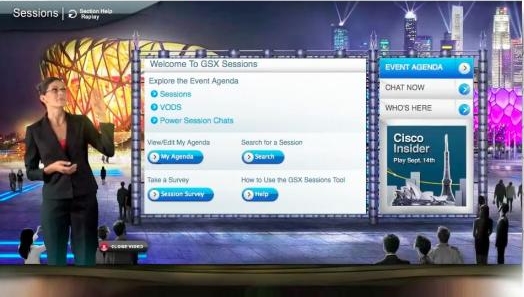One year ago (nearly to this day), Cisco Systems announced the cancellation of their annual “Global Sales Meeting†– in a statement, Cisco CEO John Chambers was quoted:
In almost all instances for business critical activities, we will be utilizing Web 2.0 collaboration technologies, such as TelePresence and WebEx, to reduce travel and event costs, while still maintaining essential customer, employee, and partner communication activities.
In the 12 months following that announcement, history was made – Cisco embarked on a 100% virtual “Global Sales Experience†(GSX), the largest and most complex virtual event the industry has seen. There are a number of excellent blog postings and articles that provide an overview of Cisco GSX:
- At 19,000, Cisco Sets the New Bar for Business Critical Virtual Meetings and Events (Virtual Edge)
- Cisco Global Sales Meeting Uses Gaming for Engagement (blogs.cisco.com)
- Cisco Links Work and Play in Huge Virtual Sales Event (MeetingsNet)
- Cisco connects sales virtually (BtoB Online)

As Manager, Global Sales Experience at Cisco, Angie Smith managed the diverse team that delivered this historic event – the team was comprised of numerous groups within Cisco, as well as a partnership of vendor companies, including George P. Johnson, jUXT Interactive and InXpo.
Best Practices – Virtual Sales Meeting
Use the same approach to meeting planning whether the event is virtual, physical or hybrid. Two basic elements to define up front:
- The objectives of the sales meeting
- The precise metrics that will be used to measure against the defined objectives
According to Smith, “Be sure you are very clear on your objectives and you are able to map out how you are measured on successâ€. Another key consideration is determining what works well in a virtual gathering, compared to a face-to-face gathering. For Smith, the virtual experience was highly effective in delivering education (e.g. sessions, presentations, downloadable content from exhibitor booths) and collaboration (e.g. virtual attendees interacting and engaging in team play).
However, she finds recognition to be more effective in a physical setting – it’s one thing to hear your name announced as a top performer sitting in front of your computer, but it’s an entirely different experience to receive an award on stage with thousands of your peers in the (physical) audience.
With regard to project planning for large scale virtual sales meetings, Smith provides these tips:
- Don’t fool yourself into thinking that virtual is “easier†than physical – it’s not.
- Start the planning meetings as early as possible – compressed schedules increase execution risk and can result in “burn-out†of your extended team.
- Assemble the team up front – “have your technology vendors, content developers and creative arms talking from day one,” said Smith.

Considerations for a Hybrid Sales Meeting
So what’s next? While the 100% virtual model was a monumental success, Smith is considering a hybrid model for the 2010 global sales meeting. According to Smith, “I don’t think virtual will go away, ever. I believe for Cisco if we are going to still focus on the same objectives around ‘Communicate, Motivate and Recognize’, we are considering a hybrid style of event that allows the best of both worlds. In-person gatherings for small groups to feed the need for personal 1:1 networking and then a virtual opportunity to cover more content and reach more people.â€
Planning for a hybrid sales meeting introduces a wrinkle into the planning process – now, when meeting planners define their objectives and success metrics, it’s critical to map those objectives/metrics to the “right†venue (physical, virtual or both). For each objective, you’ll want to define:
- In what venue you’ll achieve the objective (physical, virtual or both)
- How is the objective achieved in that venue
- How are the metrics measured and evaluated in that venue
According to Smith, “communication and information sharing are about the same in person or virtually. A sales organization needs motivation and recognition to be successful, this is typically done better in person as it is subjective and based on human interaction.â€Â For 2010, Smith is considering a 3-week hybrid event that alternates between virtual and physical.
The alternating of virtual/physical/virtual creates a continuous flow of activity across venues – “bringing together teams that may have worked virtually for one week, then meet live and in person for a day the next week and then bringing them together again online will truly teach them the power of collaboration and community building without even tryingâ€, said Smith.
In closing, Smith urges sales meeting planners to keep the “fun factor†in mind. As long as you’re delivering on your stated business objectives, then go the extra mile to ensure that attendees (and the meeting planners!) have fun – “be sure to have some fun in person and online, as it really expands everyone’s perception of how we can Work, Live, Play and Learn together…. Differently.â€
Article reprinted with permission from Virtual InSights.
- Mobile revolution arrives for virtual events - May 4, 2011
- Six tips for selling virtual event sponsorships - March 25, 2011
- Generate Sales Leads With Virtual Events - December 14, 2010
